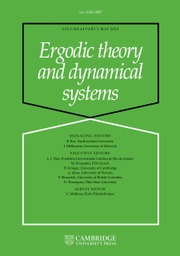No CrossRef data available.
Article contents
On the critical regularity of nilpotent groups acting on the interval: the metabelian case
Published online by Cambridge University Press: 24 September 2024
Abstract
Let G be a torsion-free, finitely generated, nilpotent and metabelian group. In this work, we show that G embeds into the group of orientation-preserving  $C^{1+\alpha }$-diffeomorphisms of the compact interval for all
$C^{1+\alpha }$-diffeomorphisms of the compact interval for all  $\alpha < 1/k$, where k is the torsion-free rank of
$\alpha < 1/k$, where k is the torsion-free rank of  $G/A$ and A is a maximal abelian subgroup. We show that, in many situations, the corresponding
$G/A$ and A is a maximal abelian subgroup. We show that, in many situations, the corresponding  $1/k$ is critical in the sense that there is no embedding of G with higher regularity. A particularly nice family where this happens is the family of
$1/k$ is critical in the sense that there is no embedding of G with higher regularity. A particularly nice family where this happens is the family of  $(2n+1)$-dimensional Heisenberg groups, for which we can show that the critical regularity is equal to
$(2n+1)$-dimensional Heisenberg groups, for which we can show that the critical regularity is equal to  $1+1/n$.
$1+1/n$.
- Type
- Original Article
- Information
- Copyright
- © The Author(s), 2024. Published by Cambridge University Press



